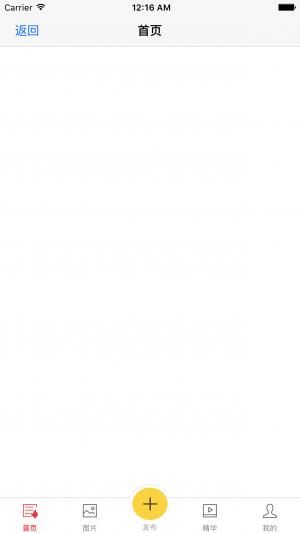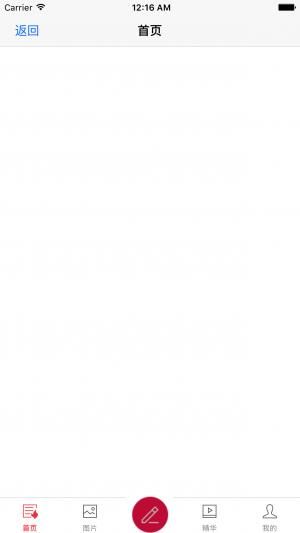常见的三种自定义tabBar
效果图
Demo 下载地址: ZYCustomTabBar 觉得有用的话, 请给一个star
demo里面有三种自定义方式
实现思路
- UITabBarItem可以看做是一种特殊的button, 可以创建自定义的button
- 创建自定义的ZYTabBarViewController继承UITabBarController
- 创建一个继承自UITabBar的实体类ZYTabbar
- 通过按钮的点击事件,设置代理
- typeOne: 实现中间只有图片的tabBar
#pragma mark - custom method
// 初始化所有的子控制器
- (void)setupAllChildViewControllers {
// 1.ONE
UIViewController *one = [[UIViewController alloc] init];
one.view.backgroundColor = [UIColor whiteColor];
[self addChildViewController:one title:@"首页" imageName:@"tabbar_news" selectedImageName:@"tabbar_news_hl"];
// 2.TWO
UIViewController *two = [[UIViewController alloc] init];
two.view.backgroundColor = [UIColor magentaColor];
[self addChildViewController:two title:@"图片" imageName:@"tabbar_picture" selectedImageName:@"tabbar_picture_hl"];
if (self.tabBarType == typeOne) {
// 2.publishButton
UIViewController *publish = [[UIViewController alloc] init];
publish.view.backgroundColor = [UIColor blueColor];
two.view.backgroundColor = [UIColor magentaColor];
[self addChildViewController:publish title:@"publish" imageName:@"tabbar_write" selectedImageName:@"tabbar_write"];
}
// 3.THREE
UIViewController *three = [[UIViewController alloc] init];
three.view.backgroundColor = [UIColor cyanColor];
[self addChildViewController:three title:@"精华" imageName:@"tabbar_video" selectedImageName:@"tabbar_video_hl"];
// 4.FOUR
UIViewController *four = [[UIViewController alloc] init];
four.view.backgroundColor = [UIColor yellowColor];
[self addChildViewController:four title:@"我的" imageName:@"tabbar_setting" selectedImageName:@"tabbar_setting_hl"];
}
/**
* 初始化一个子控制器
*
* @param childVc 需要初始化的子控制器
* @param title 标题
* @param imageName 图标
* @param selectedImageName 选中的图标
*/
- (void)addChildViewController:(UIViewController *)childVc title:(NSString *)title imageName:(NSString *)imageName selectedImageName:(NSString *)selectedImageName {
// 1.设置控制器的属性
childVc.title = title;
// 设置图标
childVc.tabBarItem.image = [[UIImage imageNamed:imageName] imageWithRenderingMode:UIImageRenderingModeAlwaysOriginal];
// 设置选中的图标
childVc.tabBarItem.selectedImage = [[UIImage imageNamed:selectedImageName] imageWithRenderingMode:UIImageRenderingModeAlwaysOriginal];
[childVc.tabBarItem setTitleTextAttributes:@{NSForegroundColorAttributeName:[UIColor redColor],NSFontAttributeName:[UIFont systemFontOfSize:13.f]} forState:UIControlStateSelected];
//方式一 (self.tabBarType == typeOne) 只有图片没有文字tabbar
if ([title isEqualToString:@"publish"]) {
//tabBar图片居中显示,不显示文字
childVc.title = @"";
childVc.tabBarItem.imageInsets = UIEdgeInsetsMake(5, 0, -5, 0);
}
// 2.包装一个导航控制器
ZYNavigationVc *nav = [[ZYNavigationVc alloc] initWithRootViewController:childVc];
[self addChildViewController:nav];
}
Demo里面的三种方式是采用枚举来区分的
#import
typedef NS_ENUM(NSInteger, TabBarType) {
typeOne = 0,
typeTwo = 1,
typeThree = 2
};
@interface ZYTabBarViewController : UITabBarController
@property (nonatomic, assign) TabBarType tabBarType;
@end
typeOne 需要添加的代码
if (self.tabBarType == typeOne) { UIViewController *publish = [[UIViewController alloc] init]; publish.view.backgroundColor = [UIColor blueColor]; two.view.backgroundColor = [UIColor magentaColor]; [self addChildViewController:publish title:@"publish" imageName:@"tabbar_write" selectedImageName:@"tabbar_write"]; }
//方式一 (self.tabBarType == typeOne) 只有图片没有文字tabbar if ([title isEqualToString:@"publish"]) { //tabBar图片居中显示,不显示文字 childVc.title = @""; childVc.tabBarItem.imageInsets = UIEdgeInsetsMake(5, 0, -5, 0); }
typeOne实现思路:
这是一种投机取巧的方式, 主要是把title设置为@"", 在设置图片的偏移
typeTwo实现思路:
通过自定义UITabBar
.m文件核心代码:
- (void)layoutSubviews {
[super layoutSubviews];
//按钮的尺寸
CGFloat buttonW = self.frame.size.width/5.0;
CGFloat buttonH = self.frame.size.height;
self.publishButton.center = CGPointMake(self.frame.size.width * 0.5, buttonH * 0.5);
//中间凸起tabBar
if (_isCircle) {
self.publishButton.center = CGPointMake(self.frame.size.width * 0.5, self.frame.size.height/2.0 - 20);
self.label.center = CGPointMake(self.publishButton.center.x, CGRectGetMaxY(self.publishButton.frame)+10);
}
//按钮索引
NSInteger tabbarIndex = 0;
for (UIView * subview in self.subviews) {
if ([subview isKindOfClass:NSClassFromString(@"UITabBarButton")]) {
subview.frame = CGRectMake(tabbarIndex * buttonW, 0, buttonW, buttonH);
tabbarIndex ++;
//把中间的按钮位置预留出来
if (tabbarIndex == 2) {
tabbarIndex ++;
}
}
}
}
- (void)publishClick {
if ([self.ZYDelegate respondsToSelector:@selector(tabBarDidClickPlusButton)]) {
[self.ZYDelegate tabBarDidClickPlusButton];
}
}
在自定义的ZYTabBarViewController利用kvc替换系统的tabBar, 这里的self.tabBarType == typeTwo 就是表示第二种自定义tabBar
ZYTabbar * tabbar = [[ZYTabbar alloc] init];
tabbar.ZYDelegate = self;
self.delegate = self;
//注意:因为是系统的tabBar是readonly的,所以用KVC方法替换
if (self.tabBarType == typeTwo) {
[self setValue:tabbar forKey:@"tabBar"];
}else if (self.tabBarType == typeThree) {
tabbar.isCircle = YES;
[self setValue:tabbar forKey:@"tabBar"];
}
[self setupAllChildViewControllers];
typeThree实现思路:
和typeTwo基本一致, 就是把自定义button的背景图片以及位置移动一下.并设置label的位置
代码如下:
#pragma mark -- setter
- (void)setIsCircle:(BOOL)isCircle {
_isCircle = isCircle;
if (isCircle) {
[self.publishButton setBackgroundImage:[UIImage imageNamed:@"post_normal"] forState:UIControlStateNormal];
[self.publishButton setBackgroundImage:[UIImage imageNamed:@"post_normal"] forState:UIControlStateHighlighted];
self.publishButton.center = CGPointMake(self.frame.size.width * 0.5, self.frame.size.height/2.0 - 20);
self.label.center = CGPointMake(self.publishButton.center.x, CGRectGetMaxY(self.publishButton.frame)+10);
[self addSubview:self.label];
}
}
这里在ZYTabbar声明一个isCircle主要是为了区分方式二和方式三, 并实现isCircle的setter方法, 来修改button的背景图片, 由于layoutSubviews这个方法是在isCircle的setter方法之后调用的, 所以我们还需要在layoutSubviews这个方法内部修改button, label的位置
- (void)layoutSubviews {
[super layoutSubviews];
//按钮的尺寸
CGFloat buttonW = self.frame.size.width/5.0;
CGFloat buttonH = self.frame.size.height;
self.publishButton.center = CGPointMake(self.frame.size.width * 0.5, buttonH * 0.5);
//中间凸起tabBar
if (_isCircle) {
self.publishButton.center = CGPointMake(self.frame.size.width * 0.5, self.frame.size.height/2.0 - 20);
self.label.center = CGPointMake(self.publishButton.center.x, CGRectGetMaxY(self.publishButton.frame)+10);
}
//按钮索引
NSInteger tabbarIndex = 0;
for (UIView * subview in self.subviews) {
if ([subview isKindOfClass:NSClassFromString(@"UITabBarButton")]) {
subview.frame = CGRectMake(tabbarIndex * buttonW, 0, buttonW, buttonH);
tabbarIndex ++;
//把中间的按钮位置预留出来
if (tabbarIndex == 2) {
tabbarIndex ++;
}
}
}
}
到这里差不多demo里面的三种自定义tabBar已经说完了.
最后说一下点击tabBar的动画效果, 代码如下:
- (void)tabBar:(UITabBar *)tabBar didSelectItem:(UITabBarItem *)item {
NSMutableArray * tabbarArr = [NSMutableArray array];
NSInteger index = [self.tabBar.items indexOfObject:item];
for (UIView *subview in tabBar.subviews) {
if ([subview isKindOfClass:NSClassFromString(@"UITabBarButton")]) {
[tabbarArr addObject:subview];
}
}
UIView * tabbarBtn = tabbarArr[index];
for (UIView * imgV in tabbarBtn.subviews) {
if ([imgV isKindOfClass:NSClassFromString(@"UITabBarSwappableImageView")]) {
CABasicAnimation*pulse = [CABasicAnimation animationWithKeyPath:@"transform.scale"];
pulse.timingFunction= [CAMediaTimingFunction functionWithName:kCAMediaTimingFunctionEaseInEaseOut];
pulse.duration = 0.2;
pulse.repeatCount= 1;
pulse.autoreverses= YES;
pulse.fromValue= [NSNumber numberWithFloat:0.7];
pulse.toValue= [NSNumber numberWithFloat:1.3];
[imgV.layer
addAnimation:pulse forKey:nil];
}
}
}
这里主要是实现UITabBarDelegate的代理方法来实现的, 需要注意的一点就是我们不需要再声明 self.tabBar.delegate = self, 因为我已经实现了UITabBarController的代理, 具体的原因我也不是很清楚, 想了解更多的话, 还是去找度娘

